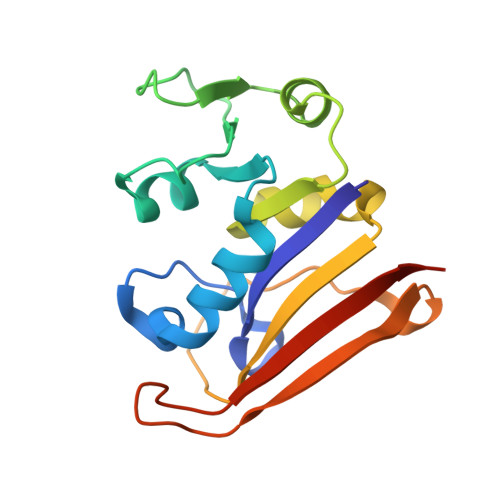The discovery of 1, 3-diamino-7H-pyrrol[3, 2-f]quinazoline compounds as potent antimicrobial antifolates.
Li, Y., Ouyang, Y., Wu, H., Wang, P., Huang, Y., Li, X., Chen, H., Sun, Y., Hu, X., Wang, X., Li, G., Lu, Y., Li, C., Lu, X., Pang, J., Nie, T., Sang, X., Dong, L., Dong, W., Jiang, J., Paterson, I.C., Yang, X., Hong, W., Wang, H., You, X.(2022) Eur J Med Chem 228: 113979-113979
- PubMed: 34802838
- DOI: https://doi.org/10.1016/j.ejmech.2021.113979
- Primary Citation of Related Structures:
7F3B - PubMed Abstract:
The shortage of new antibiotics makes infections caused by gram-negative (G - ) bacteria a significant clinical problem. The key enzymes involved in folate biosynthesis represent important targets for drug discovery, and new antifolates with novel mechanisms are urgently needed. By targeting to dihydrofolate reductase (DHFR), a series of 1,3-diamino-7H-pyrrol[3,2-f]quinazoline (PQZ) compounds were designed, and exhibited potent antibacterial activities in vitro, especially against multi-drug resistant G - strains. Multiple experiments indicated that PQZ compounds contain a different molecular mechanism against the typical DHFR inhibitor, trimethoprim (TMP), and the thymidylate synthase (TS) was identified as another potential but a relatively weak target. A significant synergism between the representative compound, OYYF-175, and sulfamethoxazole (SMZ) was observed with a strong cumulative and significantly bactericidal effect at extremely low concentrations (2 μg/mL for SMZ and 0.03 pg/mL for OYYF-175), which could be resulted from the simultaneous inhibition of dihydropteroate synthase (DHPS), DHFR and TS. PQZ compounds exhibited therapeutic effects in a mouse model of intraperitoneal infections caused by Escherichia coli (E. coli). The co-crystal structure of OYYF-175-DHFR was solved and the detailed interactions were provided. The inhibitors reported represent innovative chemical structures with novel molecular mechanism of action, which will benefit the generation of new, efficacious bactericidal compounds.
- Beijing Key Laboratory of Antimicrobial Agents/Laboratory of Pharmacology, Institute of Medicinal Biotechnology, Chinese Academy of Medical Sciences & Peking Union Medical College, Beijing, 100050, China.
Organizational Affiliation:


















